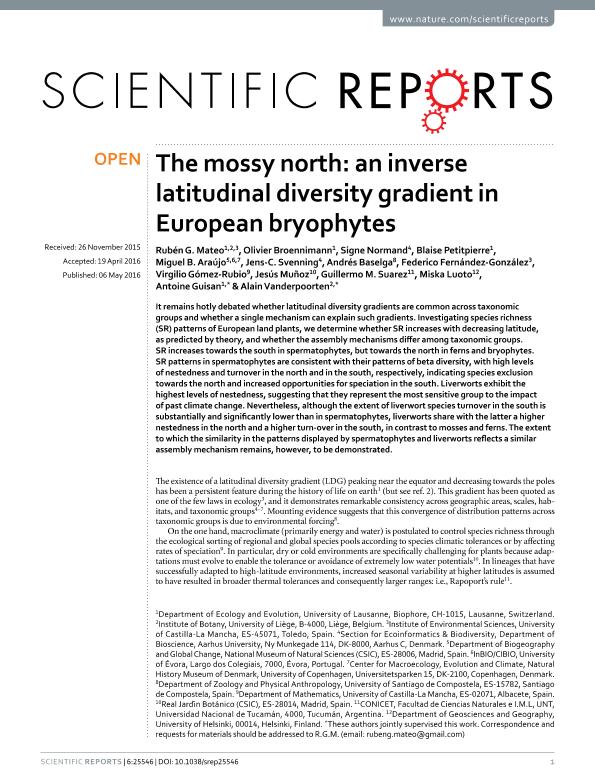Artículo
The mossy north: An inverse latitudinal diversity gradient in European bryophytes
Mateo, Rubén G.; Broennimann, Olivier; Normand, Signe; Petitpierre, Blaise; Araújo, Miguel B.; Svenning, Jens-C.; Baselga, Andrés; Fernández González, Federico; Gómez Rubio, Virgilio; Munõz, Jesús; Suarez, Guillermo Martin ; Luoto, Miska; Guisan, Antoine; Vanderpoorten, Alain
; Luoto, Miska; Guisan, Antoine; Vanderpoorten, Alain
 ; Luoto, Miska; Guisan, Antoine; Vanderpoorten, Alain
; Luoto, Miska; Guisan, Antoine; Vanderpoorten, Alain
Fecha de publicación:
05/2016
Editorial:
Nature Publishing Group
Revista:
Scientific Reports
ISSN:
2045-2322
Idioma:
Inglés
Tipo de recurso:
Artículo publicado
Clasificación temática:
Resumen
It remains hotly debated whether latitudinal diversity gradients are common across taxonomic groups and whether a single mechanism can explain such gradients. Investigating species richness (SR) patterns of European land plants, we determine whether SR increases with decreasing latitude, as predicted by theory, and whether the assembly mechanisms differ among taxonomic groups. SR increases towards the south in spermatophytes, but towards the north in ferns and bryophytes. SR patterns in spermatophytes are consistent with their patterns of beta diversity, with high levels of nestedness and turnover in the north and in the south, respectively, indicating species exclusion towards the north and increased opportunities for speciation in the south. Liverworts exhibit the highest levels of nestedness, suggesting that they represent the most sensitive group to the impact of past climate change. Nevertheless, although the extent of liverwort species turnover in the south is substantially and significantly lower than in spermatophytes, liverworts share with the latter a higher nestedness in the north and a higher turn-over in the south, in contrast to mosses and ferns. The extent to which the similarity in the patterns displayed by spermatophytes and liverworts reflects a similar assembly mechanism remains, however, to be demonstrated.
Palabras clave:
Bryophyta
,
Diversity
,
Europa
,
Vascular Plants
Archivos asociados
Licencia
Identificadores
Colecciones
Articulos(UEL)
Articulos de UNIDAD EJECUTORA LILLO
Articulos de UNIDAD EJECUTORA LILLO
Citación
Mateo, Rubén G.; Broennimann, Olivier; Normand, Signe; Petitpierre, Blaise; Araújo, Miguel B.; et al.; The mossy north: An inverse latitudinal diversity gradient in European bryophytes; Nature Publishing Group; Scientific Reports; 6; 5-2016; 1-9
Compartir
Altmétricas



